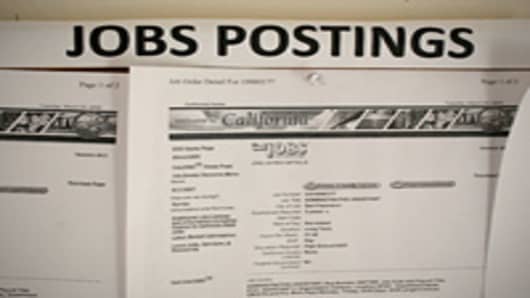The economy is expected to have added far fewer jobs in April than it did earlier in the year, and that trend could continue for months.
Economists have been ratcheting down expectations for Friday’s nonfarm payrolls. One of the latest additions was a forecast from Goldman Sachs that put April job growth at just 125,000, barely above the 120,000 jobs added in March. On Friday, the consensus forecast for Wall Street economists stood at 159,000 nonfarm payrolls in April, and an unemployment rate of 8.2 percent, and Goldman’s is now among the lowest forecasts.
The warm winter weather is credited with having bumped up job growth to a pace of 245,000 for December through February, as companies brought on workers who might not have been hired until spring. The surprise, sharp drop off in March job growth is being blamed on the payback from adding those jobs earlier in the year, and the same trend will impact April’s number.
“We’re looking for 150,000” nonfarm payrolls, said Dean Maki, chief U.S. economist at Barclays. “If we’re right, things will improve as these weather effects wear off. We would be expecting job growth to improve after the next couple of months.”
Maki said job growth could actually be about 200,000. “If there was no weather effect, that’s what we think we’d be printing right now,” he said.
Goldman Sachs economist Andrew Tilton does not expect job creation to return to the 200,000-plus level for some time.
“We don’t think we’ll go back soon because we don’t think that’s consistent with the rate of growth in the economy, which we’re expecting is around 2 percent,” Tilton said.
He said the rate of job growth is more likely 150,000 to 175,000, without the weather effect.
Tilton said he also expects jobs data for both April and May to be affected by the reversal of the weather-related job growth. Commercial construction was one area that added during the warm winter. Mining, logging, some manufacturing and weather-sensitive retail, like car dealers, can also be affected by the weather.
One factor that helped boost job growth in the first and fourth quarter was the recovery from last year’s slowdown. Tilton said businesses pulled back as a result of the debt ceiling debate in Washington.
“Businesses actually cut inventory in the third quarter. When it became clear the world wasn’t falling off a cliff, people went back to their normal behavior,” he said.
Now inventory building is slowing down.
Tilton said there may be one bright spot in the Friday employment report. He points to a record loss of 80,000 jobs at general merchandise retailers in February and March. That number seems to be too high and it could be adjusted in the April report, he said.
“Bottom line, the last report was weak, not shocking. I think this report will surprise more people,” he said.
Follow Patti Domm on Twitter: @pattidommQuestions? Comments? Email us at marketinsider@cnbc.com



